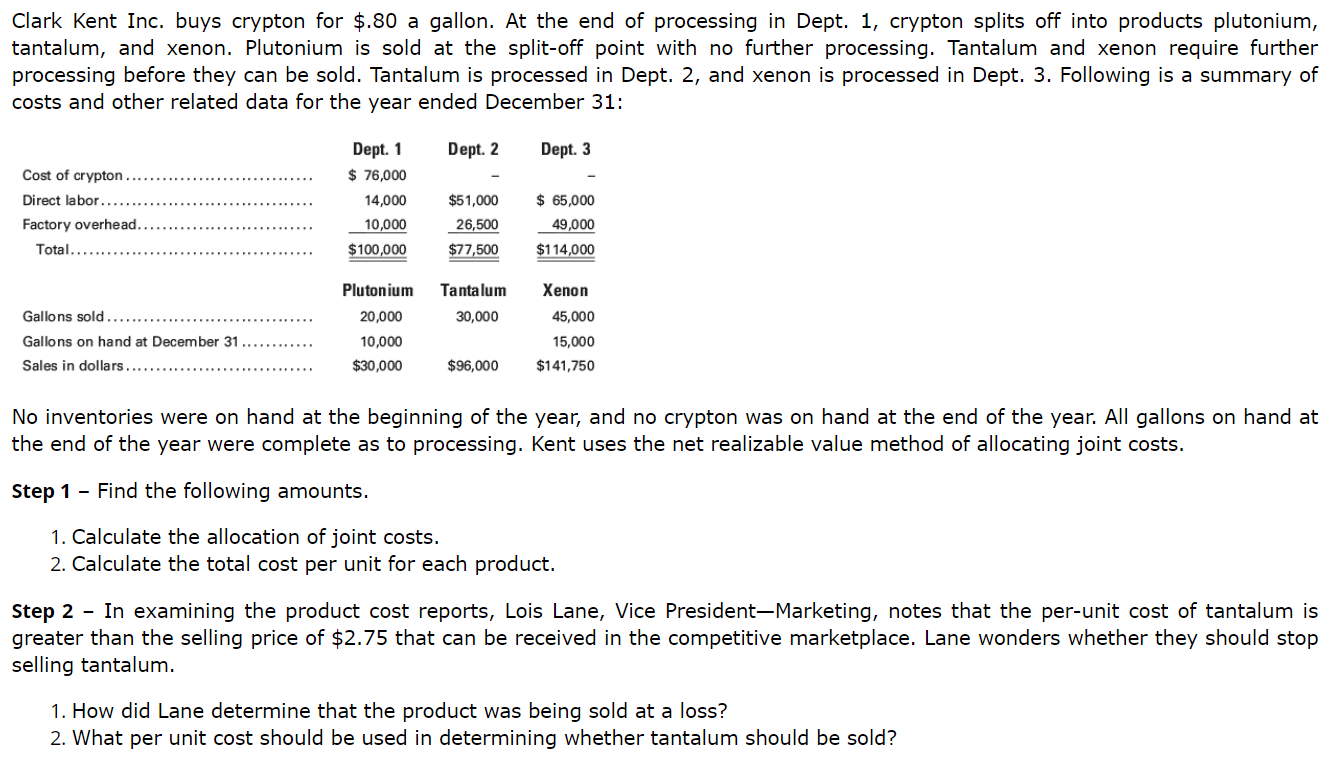Clark Kent Inc. buys crypton for $.80 a gallon. At the end of processing in Dept. 1, crypton splits off into products plutonium, tantalum, and xenon. Plutonium is sold at the split-off point with no further processing. Tantalum and xenon require further processing before they can be sold. Tantalum is processed in Dept. 2, and xenon is processed in Dept. 3. Following is a summary of costs and other related data for the year ended December 31: Dept. 1 Dept. 2 14,000 $51,000 $65,000 ...10,000 26,500 49,000 Factory overhead.... Plutonium Tantalum Xenon 45,000 15,000 $96,000$141,750 20,000 10,000 $30,000 30,000 No inventories were on hand at the beginning of the year, and no crypton was on hand at the end of the year. All gallons on hand at the end of the year were complete as to processing. Kent uses the net realizable value method of allocating joint costs. Step 1 - Find the following amounts. 1. Calculate the allocation of joint costs. 2. Calculate the total cost per unit for each product. Step 2 - In examining the product cost reports, Lois Lane, Vice President-Marketing, notes that the per-unit cost of tantalum is greater than the selling price of $2.75 that can be received in the competitive marketplace. Lane wonders whether they should stop selling tantalum 1. How did Lane determine that the product was being sold at a loss? 2. What per unit cost should be used in determining whether tantalum should be sold?
Clark Kent Inc. buys crypton for $.80 a gallon. At the end of processing in Dept. 1, crypton splits off into products plutonium, tantalum, and xenon. Plutonium is sold at the split-off point with no further processing. Tantalum and xenon require further processing before they can be sold. Tantalum is processed in Dept. 2, and xenon is processed in Dept. 3. Following is a summary of costs and other related data for the year ended December 31: Dept. 1 Dept. 2 14,000 $51,000 $65,000 ...10,000 26,500 49,000 Factory overhead.... Plutonium Tantalum Xenon 45,000 15,000 $96,000$141,750 20,000 10,000 $30,000 30,000 No inventories were on hand at the beginning of the year, and no crypton was on hand at the end of the year. All gallons on hand at the end of the year were complete as to processing. Kent uses the net realizable value method of allocating joint costs. Step 1 - Find the following amounts. 1. Calculate the allocation of joint costs. 2. Calculate the total cost per unit for each product. Step 2 - In examining the product cost reports, Lois Lane, Vice President-Marketing, notes that the per-unit cost of tantalum is greater than the selling price of $2.75 that can be received in the competitive marketplace. Lane wonders whether they should stop selling tantalum 1. How did Lane determine that the product was being sold at a loss? 2. What per unit cost should be used in determining whether tantalum should be sold?
Principles of Cost Accounting
17th Edition
ISBN:9781305087408
Author:Edward J. Vanderbeck, Maria R. Mitchell
Publisher:Edward J. Vanderbeck, Maria R. Mitchell
Chapter6: Process Cost Accounting—additional Procedures; Accounting For Joint Products And By-products
Section: Chapter Questions
Problem 1MC: Clark Kent Inc. buys crypton for $.80 a gallon. At the end of processing in Dept. 1, crypton splits...
Related questions
Question

Transcribed Image Text:Clark Kent Inc. buys crypton for $.80 a gallon. At the end of processing in Dept. 1, crypton splits off into products plutonium,
tantalum, and xenon. Plutonium is sold at the split-off point with no further processing. Tantalum and xenon require further
processing before they can be sold. Tantalum is processed in Dept. 2, and xenon is processed in Dept. 3. Following is a summary of
costs and other related data for the year ended December 31:
Dept. 1
Dept. 2
14,000
$51,000 $65,000
...10,000 26,500 49,000
Factory overhead....
Plutonium Tantalum Xenon
45,000
15,000
$96,000$141,750
20,000
10,000
$30,000
30,000
No inventories were on hand at the beginning of the year, and no crypton was on hand at the end of the year. All gallons on hand at
the end of the year were complete as to processing. Kent uses the net realizable value method of allocating joint costs.
Step 1 - Find the following amounts.
1. Calculate the allocation of joint costs.
2. Calculate the total cost per unit for each product.
Step 2 - In examining the product cost reports, Lois Lane, Vice President-Marketing, notes that the per-unit cost of tantalum is
greater than the selling price of $2.75 that can be received in the competitive marketplace. Lane wonders whether they should stop
selling tantalum
1. How did Lane determine that the product was being sold at a loss?
2. What per unit cost should be used in determining whether tantalum should be sold?
Expert Solution
This question has been solved!
Explore an expertly crafted, step-by-step solution for a thorough understanding of key concepts.
This is a popular solution!
Trending now
This is a popular solution!
Step by step
Solved in 4 steps with 3 images

Recommended textbooks for you

Principles of Cost Accounting
Accounting
ISBN:
9781305087408
Author:
Edward J. Vanderbeck, Maria R. Mitchell
Publisher:
Cengage Learning

Principles of Accounting Volume 2
Accounting
ISBN:
9781947172609
Author:
OpenStax
Publisher:
OpenStax College

Managerial Accounting: The Cornerstone of Busines…
Accounting
ISBN:
9781337115773
Author:
Maryanne M. Mowen, Don R. Hansen, Dan L. Heitger
Publisher:
Cengage Learning

Principles of Cost Accounting
Accounting
ISBN:
9781305087408
Author:
Edward J. Vanderbeck, Maria R. Mitchell
Publisher:
Cengage Learning

Principles of Accounting Volume 2
Accounting
ISBN:
9781947172609
Author:
OpenStax
Publisher:
OpenStax College

Managerial Accounting: The Cornerstone of Busines…
Accounting
ISBN:
9781337115773
Author:
Maryanne M. Mowen, Don R. Hansen, Dan L. Heitger
Publisher:
Cengage Learning

Cornerstones of Cost Management (Cornerstones Ser…
Accounting
ISBN:
9781305970663
Author:
Don R. Hansen, Maryanne M. Mowen
Publisher:
Cengage Learning